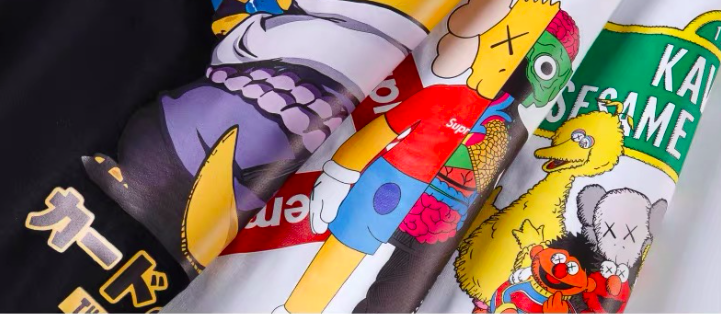There are eight distinct methods presently used to impress colored patterns on cloth:
· Hand block printing
· Perrotine printing
· Engraved copperplate printing
· Roller, cylinder, or machine printing
· Stencil printing
· Screen printing
· Digital textile printing
· Flexo textile printing
· Discharge Printing
This process is the earliest, simplest and slowest of all printing methods. A design is drawn on, or transferred to, prepared wooden blocks. A separate block is required for each distinct colour in the design. A blockcutter carves out the wood around the heavier masses first, leaving the finer and more delicate work until the last so as to avoid any risk of injuring it when the coarser parts are cut. When finished, the block has the appearance of a flat relief carving, with the design standing out. Fine details, difficult to cut in wood, are built up in strips of brass or copper, which is bent to shape and driven edgewise into the flat surface of the block. This method is known as coppering.
The printer applies colour to the block and presses it firmly and steadily on the cloth, striking it smartly on the back with a wooden mallet. The second impression is made in the same way, the printer taking care to see that it registers exactly with the first. Pins at each corner of the block join up exactly, so that the pattern can continue without a break. Each succeeding impression is made in precisely the same manner until the length of cloth is fully printed. The cloth is then wound over drying rollers. If the pattern contains several colours the cloth is first printed throughout with one colour, dried, and then printed with the next.
Block printing by hand is a slow process. But it's an interesting thing to do.It is, however, capable of yielding highly artistic results, some of which are unobtainable by any other method. William Morris used this technique in some of his fabrics.
Perrotine printing
The perrotine is a block-printing machine invented by Perrot of Rouen in 1834 and is now only of historical interest.
The perrotine is a block-printing machine invented by Perrot of Rouen in 1834 and is now only of historical interest.
This process was patented by Thomas Bell in 1785, fifteen years after his use of an engraved plate to print textiles. Bell's patent was for a machine to print six colours at once, but, probably owing to its incomplete development, it was not immediately successful. One colour could be printed with satisfactorily; the difficulty was to keep the six rollers in register with each other. This defect was overcome by Adam Parkinson of Manchester in 1785. That year, Bells machine with Parkinson's improvement was successfully employed by Messrs Livesey, Hargreaves and Company of Bamber Bridge, Preston, for the printing of calico in from two to six colours at a single operation.
Roller printing was highly productive, 10,000 to 12,000 yards being commonly printed in one day of ten hours by a single-colour machine. It is capable of reproducing every style of design, ranging from the fine delicate lines of copperplate engraving to the small repeats and limited colours of the perrotine to the broadest effects of block printing with repeats from 1 in to 80 inches. It is precise, so each portion of an elaborate multicolour pattern can be fitted into its proper place without faulty joints at the points of repetition.
The art of stenciling on textile fabrics has been practiced from time immemorial by the Japanese, and found increasing employment in Europe for certain classes of decorative work on woven goods during the late 19th century.
A pattern is cut from a sheet of stout paper or thin metal with a sharp-pointed knife, the uncut portions representing the part that will be left uncoloured. The sheet is laid on the fabric and colour is brushed through its interstices.
The peculiarity of stenciled patterns is that they have to be held together by ties. For instance, a complete circle cannot be cut without its centre dropping out, so its outline has to be interrupted at convenient points by ties or uncut portions. This limitation influences the design.
For single-colour work a stenciling machine was patented in 1894 by S. H. Sharp. It consists of an endless stencil plate of thin sheet steel that passes continuously over a revolving cast iron cylinder. The cloth to be ornamented passes between the two and the colour is forced onto it through the holes in the stencil by mechanical means.
Screen printing is by far the most common technology today. Two types exist: rotary screen printing and flat (bed) screen printing. A blade (squeegee) squeezes the printing paste through openings in the screen onto the fabric.
Digital textile printing is often referred to as direct-to-garment printing, DTG printing, or digital garment printing. It is a process of printing on textiles and garments using specialized or modified inkjet technology. Inkjet printing on fabric is also possible with an inkjet printer by using fabric sheets with a removable paper backing. Today, major inkjet technology manufacturers can offer specialized products designed for direct printing on textiles, not only for sampling but also for bulk production. Since the early 1990s, inkjet technology and specially developed water-based ink (known as dye-sublimation or disperse direct ink) have made it possible to print directly onto polyester fabric. This is mainly related to visual communication in retail and brand promotion (flags, banners and other point of sales applications). Printing onto nylon and silk can be done by using an acid ink. Reactive ink is used for cellulose based fibers such as cotton and linen. Inkjet technology in digital textile printing allows for single pieces, mid-run production and even long-run alternatives to screen printed fabric.
Flexo textile printing on textile fabric was successful in China in the last 4 years[when?]. Central Impression Flexo, Rubber Sleeves as the printing plate in round engraved by laser (Direct Laser Engraving), Anilox in Sleeve technologies are applicated in the area. Not only the solid, but also 6 to 8 colours in fine register, higher resolution ratio and higher productivity which are the outstanding advantages extraordinary different from the traditional screen textile printing. Aerospace Huayang, Hell system, SPGPrints and Felix Böttcher contributed their technologies and efforts.
Although most work is executed throughout by one or another of the seven distinct processes mentioned above, combinations are frequently employed. Sometimes a pattern is printed partly by machine and partly by block, and sometimes a cylindrical block is used along with engraved copper-rollers in an ordinary printing machine. The block in this latter case is in all respects, except for shape, identical with a flat wood or coppered block, but, instead of being dipped in colour, it receives its supply from an endless blanket, one part of which works in contact with colour-furnishing rollers and the other part with the cylindrical block. This block is known as a surface or peg roller. Many attempts have been made to print multicolour patterns with surface rollers alone, but hitherto with little success, owing to their irregularity in action and to the difficulty of preventing them from warping. These defects are not present in the printing of linoleum in which opaque oil colours are used, colours that neither sink into the body of the hard linoleum nor tend to warp the roller.
Lithographic printing has been applied to textile fabrics with qualified success. Its irregularity and the difficulty of registering repeats have restricted its use to the production of decorative panels, equal or smaller in size to the plate or stone.
Pad printing has been recently introduced to textile printing for the specific purpose of printing garment tags and care labels.

Contact: Betty Wong
Phone: +0086 15018500959
Tel: +0086 15018500959
Whatsapp: +0086 15018500959
Email: Betty@myjprinter.com
Add: Jinduhui Building,Xueyuan Street,Yanhu District,Yuncheng,Shanxi (No.263, Bridge West, Fuyong Qiaotou, Baoan District, Shenzhen)
We chat
